Mental Health: A Comprehensive Overview of Influencing Factors
VerifiedAdded on 2022/08/17
|7
|1752
|165
Essay
AI Summary
This essay provides a comprehensive overview of mental health, tracing its historical evolution from early treatments to modern approaches. It delves into the community mental healthcare services and their significance. The essay thoroughly examines the various social factors, including gender, race, and socioeconomic status, and how they impact mental health. It also explores the influence of political turbulence, cultural values, and environmental factors such as pollution and urbanization on mental well-being. Furthermore, the essay discusses the primary legislation governing mental health and concludes by emphasizing the interconnectedness of mental and physical health and the need for ongoing efforts to reduce stigma and improve overall well-being.
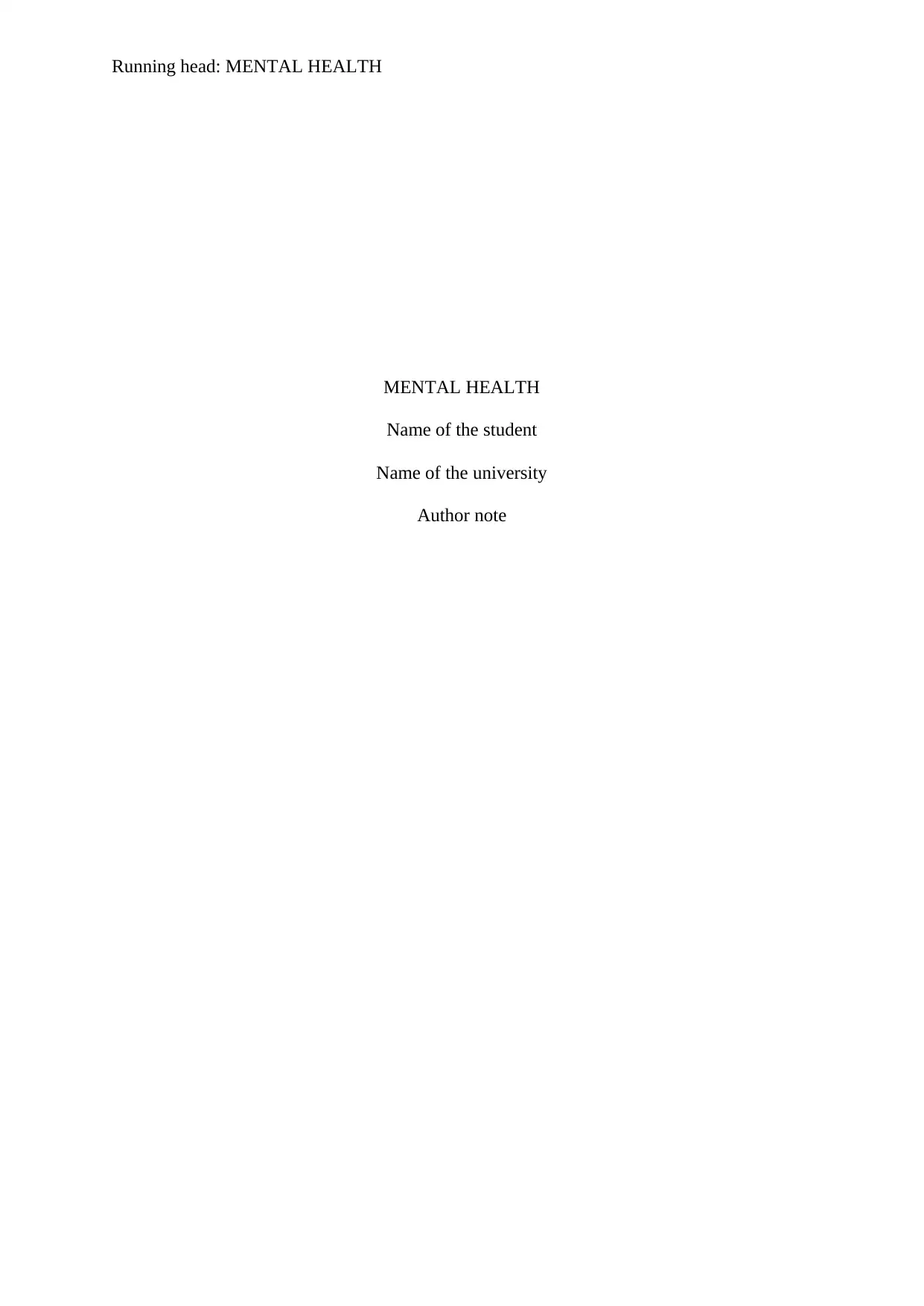
Running head: MENTAL HEALTH
MENTAL HEALTH
Name of the student
Name of the university
Author note
MENTAL HEALTH
Name of the student
Name of the university
Author note
Paraphrase This Document
Need a fresh take? Get an instant paraphrase of this document with our AI Paraphraser
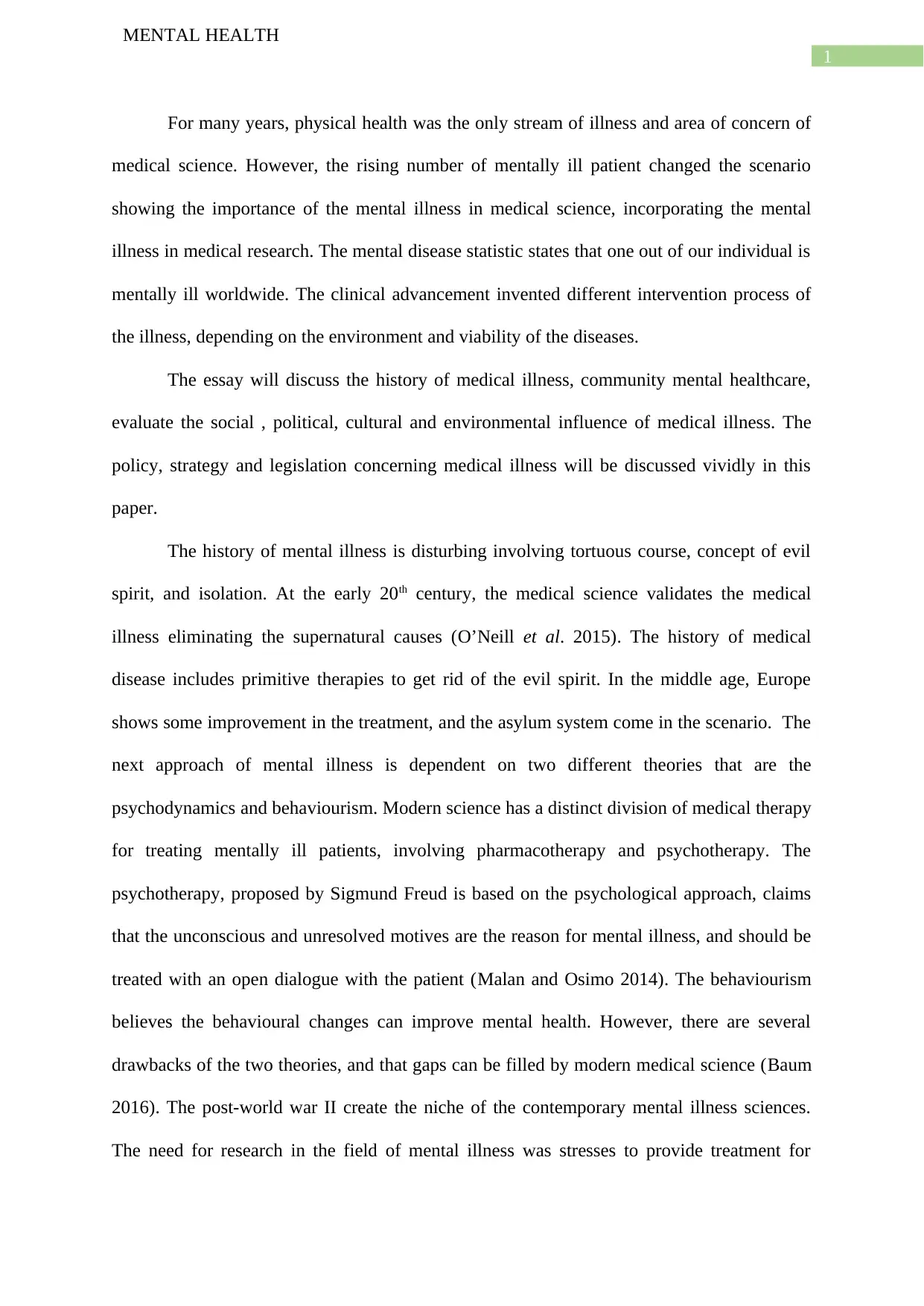
1
MENTAL HEALTH
For many years, physical health was the only stream of illness and area of concern of
medical science. However, the rising number of mentally ill patient changed the scenario
showing the importance of the mental illness in medical science, incorporating the mental
illness in medical research. The mental disease statistic states that one out of our individual is
mentally ill worldwide. The clinical advancement invented different intervention process of
the illness, depending on the environment and viability of the diseases.
The essay will discuss the history of medical illness, community mental healthcare,
evaluate the social , political, cultural and environmental influence of medical illness. The
policy, strategy and legislation concerning medical illness will be discussed vividly in this
paper.
The history of mental illness is disturbing involving tortuous course, concept of evil
spirit, and isolation. At the early 20th century, the medical science validates the medical
illness eliminating the supernatural causes (O’Neill et al. 2015). The history of medical
disease includes primitive therapies to get rid of the evil spirit. In the middle age, Europe
shows some improvement in the treatment, and the asylum system come in the scenario. The
next approach of mental illness is dependent on two different theories that are the
psychodynamics and behaviourism. Modern science has a distinct division of medical therapy
for treating mentally ill patients, involving pharmacotherapy and psychotherapy. The
psychotherapy, proposed by Sigmund Freud is based on the psychological approach, claims
that the unconscious and unresolved motives are the reason for mental illness, and should be
treated with an open dialogue with the patient (Malan and Osimo 2014). The behaviourism
believes the behavioural changes can improve mental health. However, there are several
drawbacks of the two theories, and that gaps can be filled by modern medical science (Baum
2016). The post-world war II create the niche of the contemporary mental illness sciences.
The need for research in the field of mental illness was stresses to provide treatment for
MENTAL HEALTH
For many years, physical health was the only stream of illness and area of concern of
medical science. However, the rising number of mentally ill patient changed the scenario
showing the importance of the mental illness in medical science, incorporating the mental
illness in medical research. The mental disease statistic states that one out of our individual is
mentally ill worldwide. The clinical advancement invented different intervention process of
the illness, depending on the environment and viability of the diseases.
The essay will discuss the history of medical illness, community mental healthcare,
evaluate the social , political, cultural and environmental influence of medical illness. The
policy, strategy and legislation concerning medical illness will be discussed vividly in this
paper.
The history of mental illness is disturbing involving tortuous course, concept of evil
spirit, and isolation. At the early 20th century, the medical science validates the medical
illness eliminating the supernatural causes (O’Neill et al. 2015). The history of medical
disease includes primitive therapies to get rid of the evil spirit. In the middle age, Europe
shows some improvement in the treatment, and the asylum system come in the scenario. The
next approach of mental illness is dependent on two different theories that are the
psychodynamics and behaviourism. Modern science has a distinct division of medical therapy
for treating mentally ill patients, involving pharmacotherapy and psychotherapy. The
psychotherapy, proposed by Sigmund Freud is based on the psychological approach, claims
that the unconscious and unresolved motives are the reason for mental illness, and should be
treated with an open dialogue with the patient (Malan and Osimo 2014). The behaviourism
believes the behavioural changes can improve mental health. However, there are several
drawbacks of the two theories, and that gaps can be filled by modern medical science (Baum
2016). The post-world war II create the niche of the contemporary mental illness sciences.
The need for research in the field of mental illness was stresses to provide treatment for
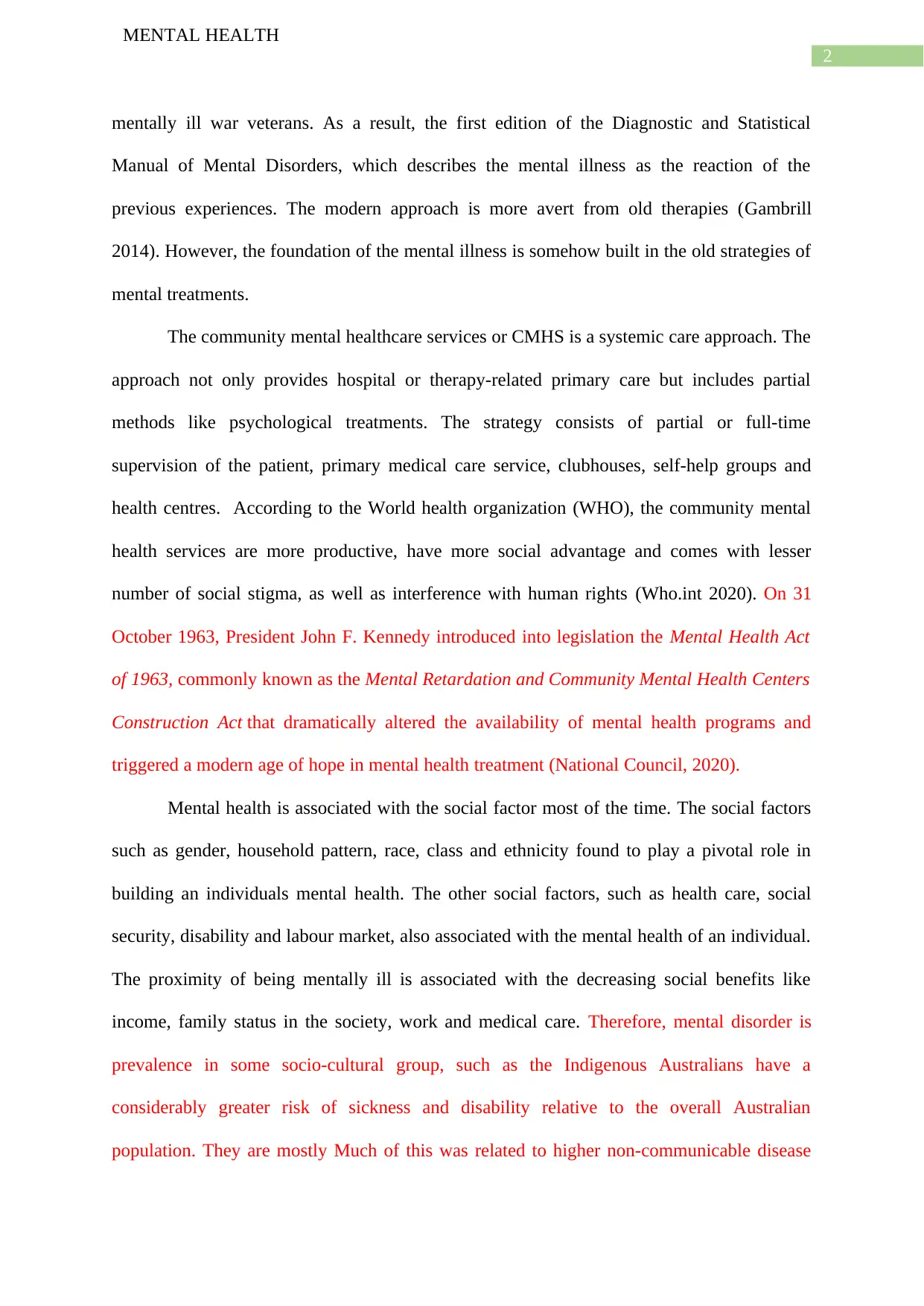
2
MENTAL HEALTH
mentally ill war veterans. As a result, the first edition of the Diagnostic and Statistical
Manual of Mental Disorders, which describes the mental illness as the reaction of the
previous experiences. The modern approach is more avert from old therapies (Gambrill
2014). However, the foundation of the mental illness is somehow built in the old strategies of
mental treatments.
The community mental healthcare services or CMHS is a systemic care approach. The
approach not only provides hospital or therapy-related primary care but includes partial
methods like psychological treatments. The strategy consists of partial or full-time
supervision of the patient, primary medical care service, clubhouses, self-help groups and
health centres. According to the World health organization (WHO), the community mental
health services are more productive, have more social advantage and comes with lesser
number of social stigma, as well as interference with human rights (Who.int 2020). On 31
October 1963, President John F. Kennedy introduced into legislation the Mental Health Act
of 1963, commonly known as the Mental Retardation and Community Mental Health Centers
Construction Act that dramatically altered the availability of mental health programs and
triggered a modern age of hope in mental health treatment (National Council, 2020).
Mental health is associated with the social factor most of the time. The social factors
such as gender, household pattern, race, class and ethnicity found to play a pivotal role in
building an individuals mental health. The other social factors, such as health care, social
security, disability and labour market, also associated with the mental health of an individual.
The proximity of being mentally ill is associated with the decreasing social benefits like
income, family status in the society, work and medical care. Therefore, mental disorder is
prevalence in some socio-cultural group, such as the Indigenous Australians have a
considerably greater risk of sickness and disability relative to the overall Australian
population. They are mostly Much of this was related to higher non-communicable disease
MENTAL HEALTH
mentally ill war veterans. As a result, the first edition of the Diagnostic and Statistical
Manual of Mental Disorders, which describes the mental illness as the reaction of the
previous experiences. The modern approach is more avert from old therapies (Gambrill
2014). However, the foundation of the mental illness is somehow built in the old strategies of
mental treatments.
The community mental healthcare services or CMHS is a systemic care approach. The
approach not only provides hospital or therapy-related primary care but includes partial
methods like psychological treatments. The strategy consists of partial or full-time
supervision of the patient, primary medical care service, clubhouses, self-help groups and
health centres. According to the World health organization (WHO), the community mental
health services are more productive, have more social advantage and comes with lesser
number of social stigma, as well as interference with human rights (Who.int 2020). On 31
October 1963, President John F. Kennedy introduced into legislation the Mental Health Act
of 1963, commonly known as the Mental Retardation and Community Mental Health Centers
Construction Act that dramatically altered the availability of mental health programs and
triggered a modern age of hope in mental health treatment (National Council, 2020).
Mental health is associated with the social factor most of the time. The social factors
such as gender, household pattern, race, class and ethnicity found to play a pivotal role in
building an individuals mental health. The other social factors, such as health care, social
security, disability and labour market, also associated with the mental health of an individual.
The proximity of being mentally ill is associated with the decreasing social benefits like
income, family status in the society, work and medical care. Therefore, mental disorder is
prevalence in some socio-cultural group, such as the Indigenous Australians have a
considerably greater risk of sickness and disability relative to the overall Australian
population. They are mostly Much of this was related to higher non-communicable disease
⊘ This is a preview!⊘
Do you want full access?
Subscribe today to unlock all pages.

Trusted by 1+ million students worldwide
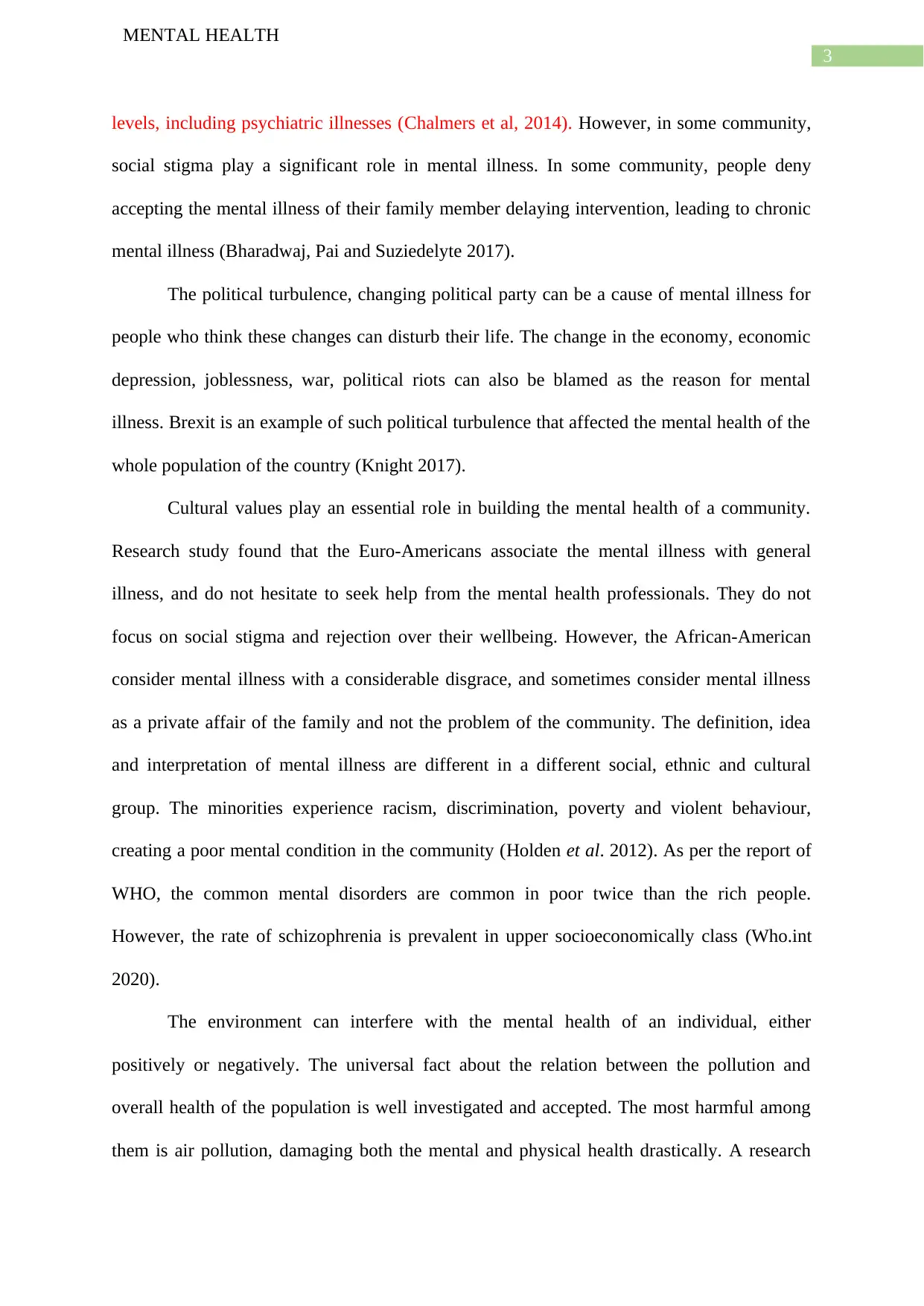
3
MENTAL HEALTH
levels, including psychiatric illnesses (Chalmers et al, 2014). However, in some community,
social stigma play a significant role in mental illness. In some community, people deny
accepting the mental illness of their family member delaying intervention, leading to chronic
mental illness (Bharadwaj, Pai and Suziedelyte 2017).
The political turbulence, changing political party can be a cause of mental illness for
people who think these changes can disturb their life. The change in the economy, economic
depression, joblessness, war, political riots can also be blamed as the reason for mental
illness. Brexit is an example of such political turbulence that affected the mental health of the
whole population of the country (Knight 2017).
Cultural values play an essential role in building the mental health of a community.
Research study found that the Euro-Americans associate the mental illness with general
illness, and do not hesitate to seek help from the mental health professionals. They do not
focus on social stigma and rejection over their wellbeing. However, the African-American
consider mental illness with a considerable disgrace, and sometimes consider mental illness
as a private affair of the family and not the problem of the community. The definition, idea
and interpretation of mental illness are different in a different social, ethnic and cultural
group. The minorities experience racism, discrimination, poverty and violent behaviour,
creating a poor mental condition in the community (Holden et al. 2012). As per the report of
WHO, the common mental disorders are common in poor twice than the rich people.
However, the rate of schizophrenia is prevalent in upper socioeconomically class (Who.int
2020).
The environment can interfere with the mental health of an individual, either
positively or negatively. The universal fact about the relation between the pollution and
overall health of the population is well investigated and accepted. The most harmful among
them is air pollution, damaging both the mental and physical health drastically. A research
MENTAL HEALTH
levels, including psychiatric illnesses (Chalmers et al, 2014). However, in some community,
social stigma play a significant role in mental illness. In some community, people deny
accepting the mental illness of their family member delaying intervention, leading to chronic
mental illness (Bharadwaj, Pai and Suziedelyte 2017).
The political turbulence, changing political party can be a cause of mental illness for
people who think these changes can disturb their life. The change in the economy, economic
depression, joblessness, war, political riots can also be blamed as the reason for mental
illness. Brexit is an example of such political turbulence that affected the mental health of the
whole population of the country (Knight 2017).
Cultural values play an essential role in building the mental health of a community.
Research study found that the Euro-Americans associate the mental illness with general
illness, and do not hesitate to seek help from the mental health professionals. They do not
focus on social stigma and rejection over their wellbeing. However, the African-American
consider mental illness with a considerable disgrace, and sometimes consider mental illness
as a private affair of the family and not the problem of the community. The definition, idea
and interpretation of mental illness are different in a different social, ethnic and cultural
group. The minorities experience racism, discrimination, poverty and violent behaviour,
creating a poor mental condition in the community (Holden et al. 2012). As per the report of
WHO, the common mental disorders are common in poor twice than the rich people.
However, the rate of schizophrenia is prevalent in upper socioeconomically class (Who.int
2020).
The environment can interfere with the mental health of an individual, either
positively or negatively. The universal fact about the relation between the pollution and
overall health of the population is well investigated and accepted. The most harmful among
them is air pollution, damaging both the mental and physical health drastically. A research
Paraphrase This Document
Need a fresh take? Get an instant paraphrase of this document with our AI Paraphraser
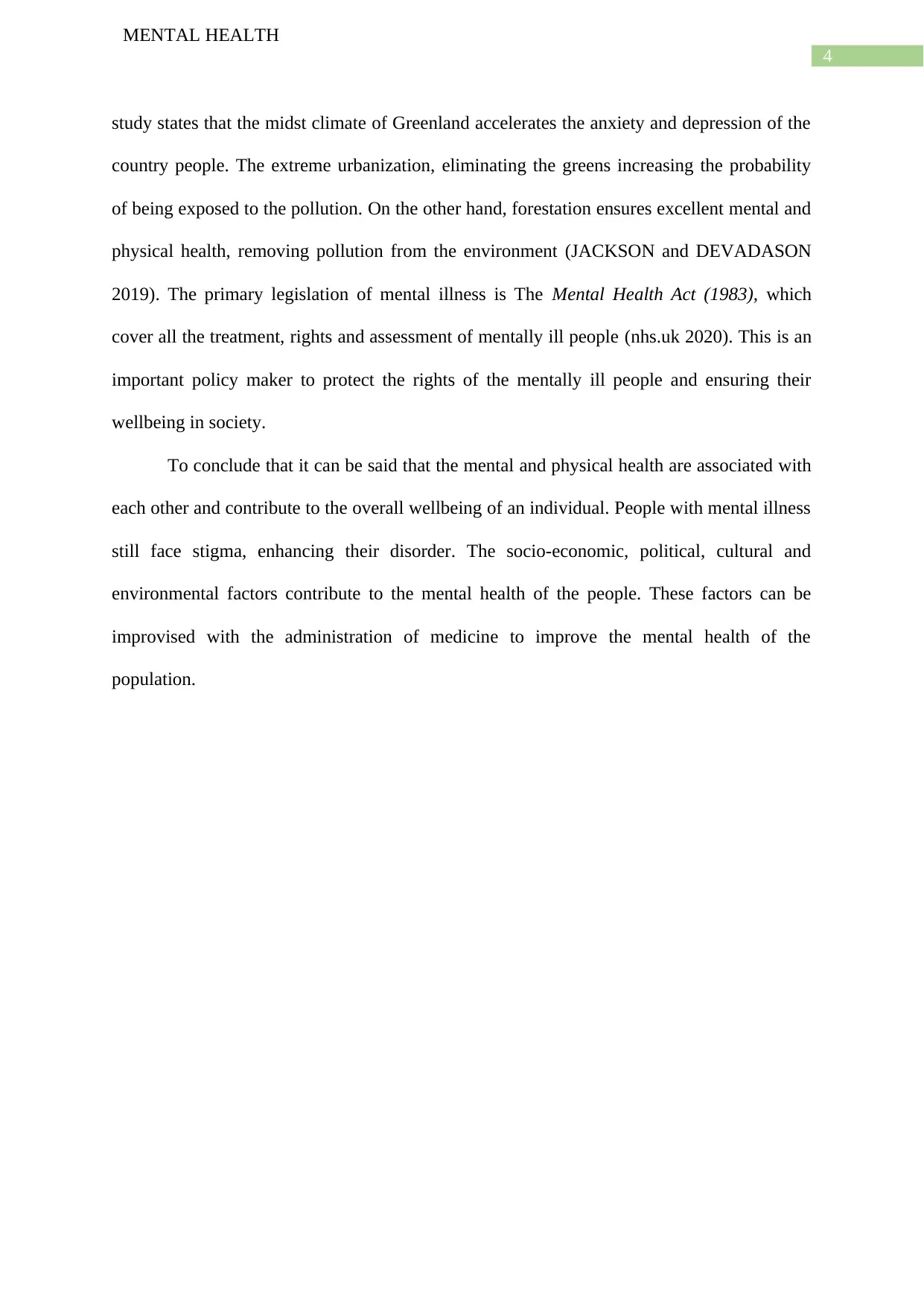
4
MENTAL HEALTH
study states that the midst climate of Greenland accelerates the anxiety and depression of the
country people. The extreme urbanization, eliminating the greens increasing the probability
of being exposed to the pollution. On the other hand, forestation ensures excellent mental and
physical health, removing pollution from the environment (JACKSON and DEVADASON
2019). The primary legislation of mental illness is The Mental Health Act (1983), which
cover all the treatment, rights and assessment of mentally ill people (nhs.uk 2020). This is an
important policy maker to protect the rights of the mentally ill people and ensuring their
wellbeing in society.
To conclude that it can be said that the mental and physical health are associated with
each other and contribute to the overall wellbeing of an individual. People with mental illness
still face stigma, enhancing their disorder. The socio-economic, political, cultural and
environmental factors contribute to the mental health of the people. These factors can be
improvised with the administration of medicine to improve the mental health of the
population.
MENTAL HEALTH
study states that the midst climate of Greenland accelerates the anxiety and depression of the
country people. The extreme urbanization, eliminating the greens increasing the probability
of being exposed to the pollution. On the other hand, forestation ensures excellent mental and
physical health, removing pollution from the environment (JACKSON and DEVADASON
2019). The primary legislation of mental illness is The Mental Health Act (1983), which
cover all the treatment, rights and assessment of mentally ill people (nhs.uk 2020). This is an
important policy maker to protect the rights of the mentally ill people and ensuring their
wellbeing in society.
To conclude that it can be said that the mental and physical health are associated with
each other and contribute to the overall wellbeing of an individual. People with mental illness
still face stigma, enhancing their disorder. The socio-economic, political, cultural and
environmental factors contribute to the mental health of the people. These factors can be
improvised with the administration of medicine to improve the mental health of the
population.
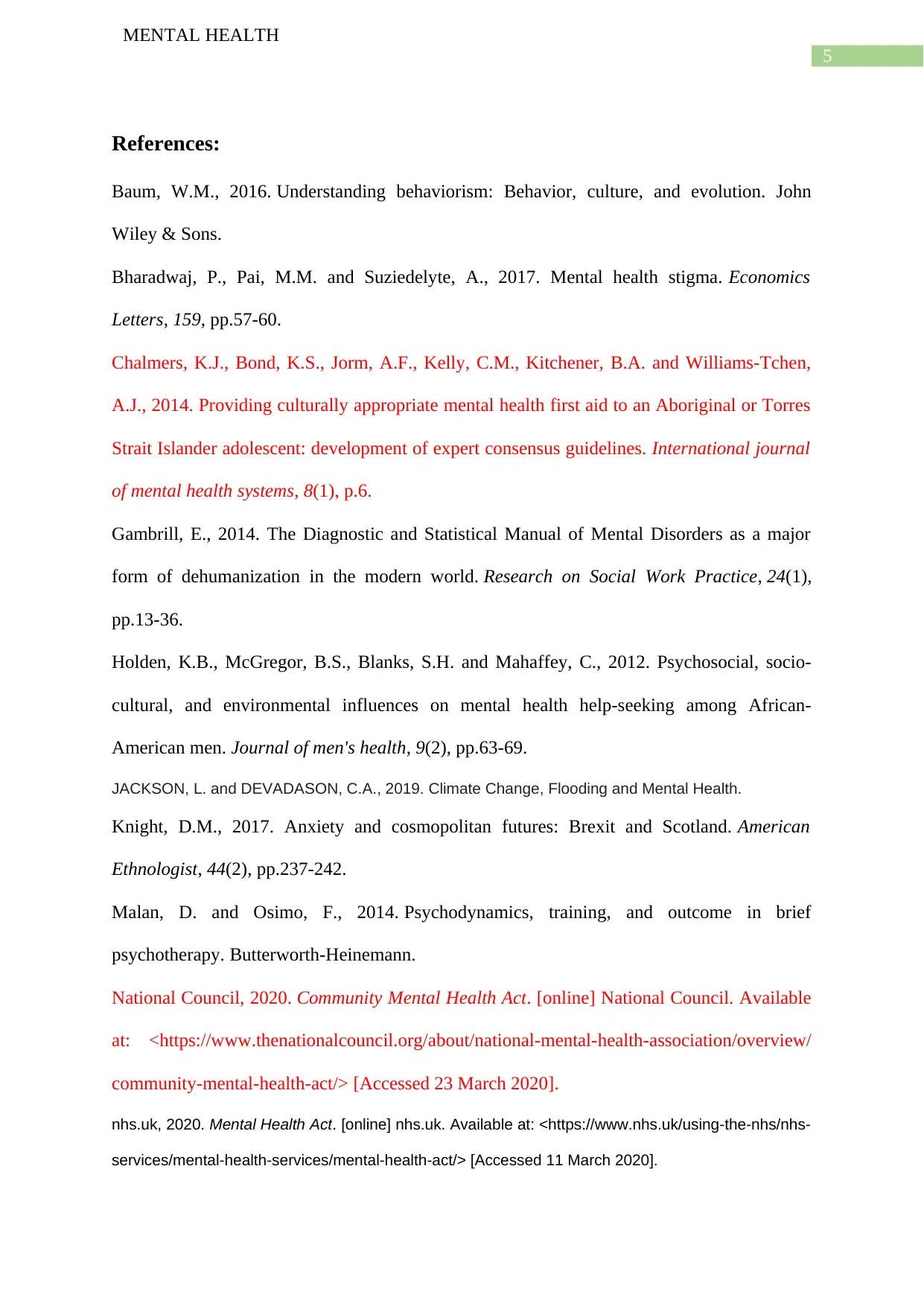
5
MENTAL HEALTH
References:
Baum, W.M., 2016. Understanding behaviorism: Behavior, culture, and evolution. John
Wiley & Sons.
Bharadwaj, P., Pai, M.M. and Suziedelyte, A., 2017. Mental health stigma. Economics
Letters, 159, pp.57-60.
Chalmers, K.J., Bond, K.S., Jorm, A.F., Kelly, C.M., Kitchener, B.A. and Williams-Tchen,
A.J., 2014. Providing culturally appropriate mental health first aid to an Aboriginal or Torres
Strait Islander adolescent: development of expert consensus guidelines. International journal
of mental health systems, 8(1), p.6.
Gambrill, E., 2014. The Diagnostic and Statistical Manual of Mental Disorders as a major
form of dehumanization in the modern world. Research on Social Work Practice, 24(1),
pp.13-36.
Holden, K.B., McGregor, B.S., Blanks, S.H. and Mahaffey, C., 2012. Psychosocial, socio-
cultural, and environmental influences on mental health help-seeking among African-
American men. Journal of men's health, 9(2), pp.63-69.
JACKSON, L. and DEVADASON, C.A., 2019. Climate Change, Flooding and Mental Health.
Knight, D.M., 2017. Anxiety and cosmopolitan futures: Brexit and Scotland. American
Ethnologist, 44(2), pp.237-242.
Malan, D. and Osimo, F., 2014. Psychodynamics, training, and outcome in brief
psychotherapy. Butterworth-Heinemann.
National Council, 2020. Community Mental Health Act. [online] National Council. Available
at: <https://www.thenationalcouncil.org/about/national-mental-health-association/overview/
community-mental-health-act/> [Accessed 23 March 2020].
nhs.uk, 2020. Mental Health Act. [online] nhs.uk. Available at: <https://www.nhs.uk/using-the-nhs/nhs-
services/mental-health-services/mental-health-act/> [Accessed 11 March 2020].
MENTAL HEALTH
References:
Baum, W.M., 2016. Understanding behaviorism: Behavior, culture, and evolution. John
Wiley & Sons.
Bharadwaj, P., Pai, M.M. and Suziedelyte, A., 2017. Mental health stigma. Economics
Letters, 159, pp.57-60.
Chalmers, K.J., Bond, K.S., Jorm, A.F., Kelly, C.M., Kitchener, B.A. and Williams-Tchen,
A.J., 2014. Providing culturally appropriate mental health first aid to an Aboriginal or Torres
Strait Islander adolescent: development of expert consensus guidelines. International journal
of mental health systems, 8(1), p.6.
Gambrill, E., 2014. The Diagnostic and Statistical Manual of Mental Disorders as a major
form of dehumanization in the modern world. Research on Social Work Practice, 24(1),
pp.13-36.
Holden, K.B., McGregor, B.S., Blanks, S.H. and Mahaffey, C., 2012. Psychosocial, socio-
cultural, and environmental influences on mental health help-seeking among African-
American men. Journal of men's health, 9(2), pp.63-69.
JACKSON, L. and DEVADASON, C.A., 2019. Climate Change, Flooding and Mental Health.
Knight, D.M., 2017. Anxiety and cosmopolitan futures: Brexit and Scotland. American
Ethnologist, 44(2), pp.237-242.
Malan, D. and Osimo, F., 2014. Psychodynamics, training, and outcome in brief
psychotherapy. Butterworth-Heinemann.
National Council, 2020. Community Mental Health Act. [online] National Council. Available
at: <https://www.thenationalcouncil.org/about/national-mental-health-association/overview/
community-mental-health-act/> [Accessed 23 March 2020].
nhs.uk, 2020. Mental Health Act. [online] nhs.uk. Available at: <https://www.nhs.uk/using-the-nhs/nhs-
services/mental-health-services/mental-health-act/> [Accessed 11 March 2020].
⊘ This is a preview!⊘
Do you want full access?
Subscribe today to unlock all pages.

Trusted by 1+ million students worldwide
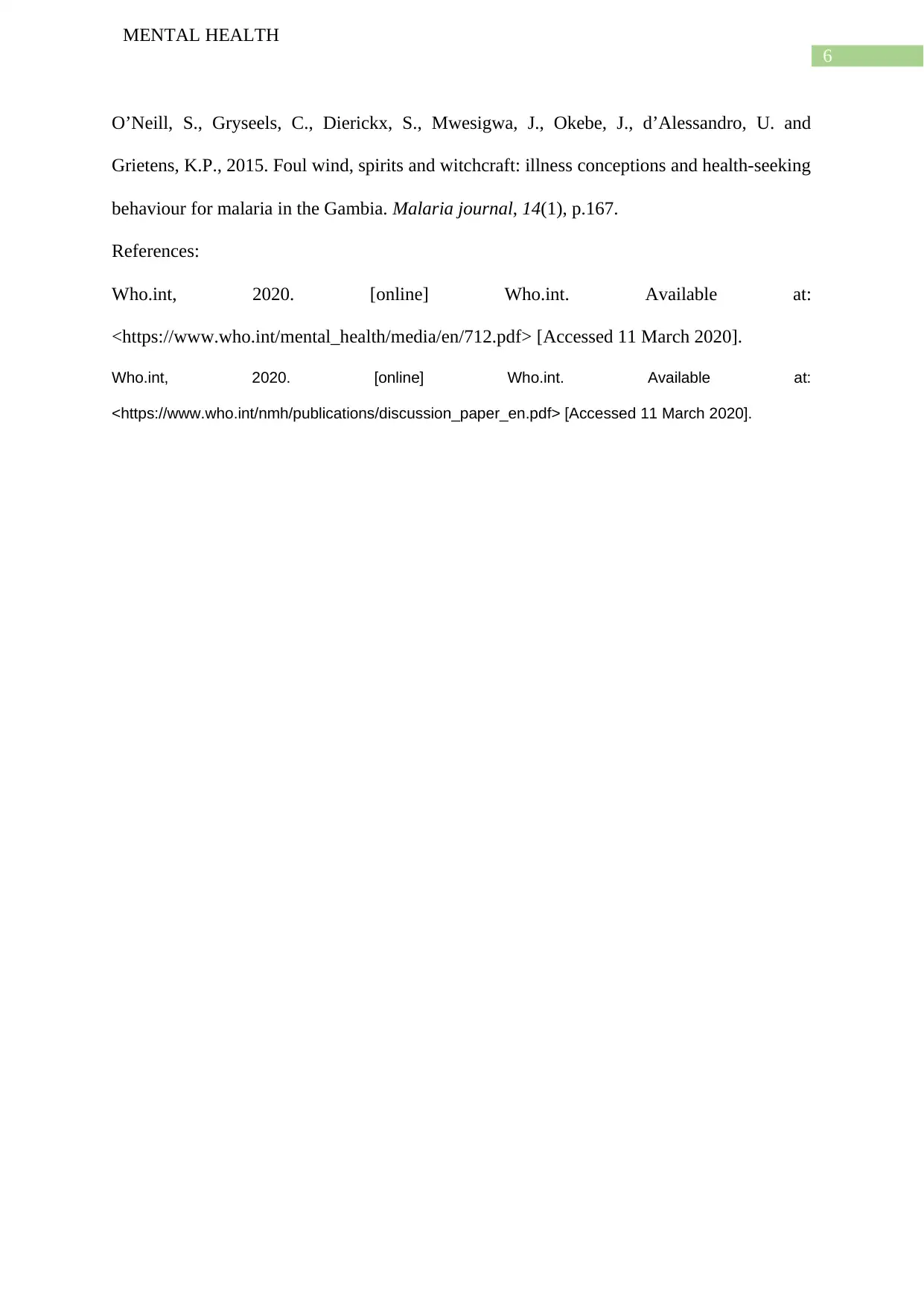
6
MENTAL HEALTH
O’Neill, S., Gryseels, C., Dierickx, S., Mwesigwa, J., Okebe, J., d’Alessandro, U. and
Grietens, K.P., 2015. Foul wind, spirits and witchcraft: illness conceptions and health-seeking
behaviour for malaria in the Gambia. Malaria journal, 14(1), p.167.
References:
Who.int, 2020. [online] Who.int. Available at:
<https://www.who.int/mental_health/media/en/712.pdf> [Accessed 11 March 2020].
Who.int, 2020. [online] Who.int. Available at:
<https://www.who.int/nmh/publications/discussion_paper_en.pdf> [Accessed 11 March 2020].
MENTAL HEALTH
O’Neill, S., Gryseels, C., Dierickx, S., Mwesigwa, J., Okebe, J., d’Alessandro, U. and
Grietens, K.P., 2015. Foul wind, spirits and witchcraft: illness conceptions and health-seeking
behaviour for malaria in the Gambia. Malaria journal, 14(1), p.167.
References:
Who.int, 2020. [online] Who.int. Available at:
<https://www.who.int/mental_health/media/en/712.pdf> [Accessed 11 March 2020].
Who.int, 2020. [online] Who.int. Available at:
<https://www.who.int/nmh/publications/discussion_paper_en.pdf> [Accessed 11 March 2020].
1 out of 7
Related Documents
Your All-in-One AI-Powered Toolkit for Academic Success.
+13062052269
info@desklib.com
Available 24*7 on WhatsApp / Email
![[object Object]](/_next/static/media/star-bottom.7253800d.svg)
Unlock your academic potential
Copyright © 2020–2025 A2Z Services. All Rights Reserved. Developed and managed by ZUCOL.





